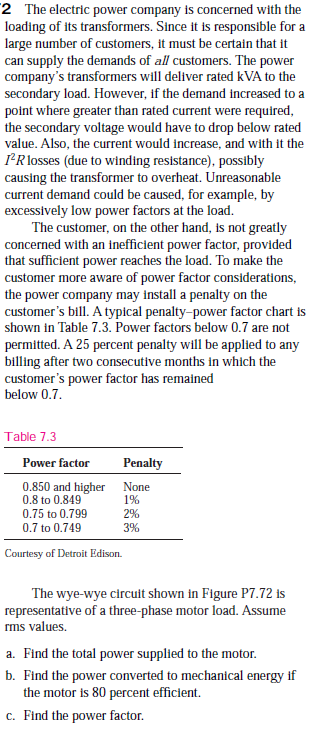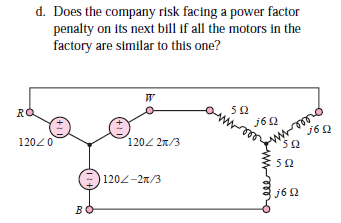2 The electric power company is concerned with the loading of its transformers. Since it is responsible for a large number of customers, it must be certain that it can supply the demands of all customers. The power company's transformers will deliver rated kVA to the secondary load. However, if the demand increased to a point where greater than rated current were required, the secondary voltage would have to drop below rated value. Also, the current would increase, and with it the PR losses (due to winding resistance), possibly causing the transformer to overheat. Unreasonable current demand could be caused, for example, by excessively low power factors at the load. The customer, on the other hand, is not greatly concerned with an inefficient power factor, provided that sufficient power reaches the load. To make the customer more aware of power factor considerations, the power company may install a penalty on the customer's bill. A typical penalty-power factor chart is shown in Table 7.3. Power factors below 0.7 are not permitted. A 25 percent penalty will be applied to any billing after two consecutive months in which the customer's power factor has remained below 0.7. Table 7.3 Power factor Penalty 0.850 and higher None 0.8 to 0.849 1% 0.75 to 0.799 2% 0.7 to 0.749 3% Courtesy of Detroit Edison. The wye-wye circult shown in Figure P7.72 is representative of a three-phase motor load. Assume rms values. a. Find the total power supplied to the motor. b. Find the power converted to mechanical energy if the motor is 80 percent efficient. c. Find the power factor. d. Does the company risk facing a power factor penalty on its next bill if all the motors in the factory are similar to this one? 52 j62 preee RO 1202 2n/3 12020 50 120Z-2n/3 j6!
2 The electric power company is concerned with the loading of its transformers. Since it is responsible for a large number of customers, it must be certain that it can supply the demands of all customers. The power company's transformers will deliver rated kVA to the secondary load. However, if the demand increased to a point where greater than rated current were required, the secondary voltage would have to drop below rated value. Also, the current would increase, and with it the PR losses (due to winding resistance), possibly causing the transformer to overheat. Unreasonable current demand could be caused, for example, by excessively low power factors at the load. The customer, on the other hand, is not greatly concerned with an inefficient power factor, provided that sufficient power reaches the load. To make the customer more aware of power factor considerations, the power company may install a penalty on the customer's bill. A typical penalty-power factor chart is shown in Table 7.3. Power factors below 0.7 are not permitted. A 25 percent penalty will be applied to any billing after two consecutive months in which the customer's power factor has remained below 0.7. Table 7.3 Power factor Penalty 0.850 and higher None 0.8 to 0.849 1% 0.75 to 0.799 2% 0.7 to 0.749 3% Courtesy of Detroit Edison. The wye-wye circult shown in Figure P7.72 is representative of a three-phase motor load. Assume rms values. a. Find the total power supplied to the motor. b. Find the power converted to mechanical energy if the motor is 80 percent efficient. c. Find the power factor. d. Does the company risk facing a power factor penalty on its next bill if all the motors in the factory are similar to this one? 52 j62 preee RO 1202 2n/3 12020 50 120Z-2n/3 j6!
Power System Analysis and Design (MindTap Course List)
6th Edition
ISBN:9781305632134
Author:J. Duncan Glover, Thomas Overbye, Mulukutla S. Sarma
Publisher:J. Duncan Glover, Thomas Overbye, Mulukutla S. Sarma
Chapter3: Power Transformers
Section: Chapter Questions
Problem 3.36P: Three single-phase two-winding transformers, each rated 25MVA,34.5/13.8kV, are connected to form a...
Related questions
Question
100%

Transcribed Image Text:2 The electric power company is concerned with the
loading of its transformers. Since it is responsible for a
large number of customers, it must be certain that it
can supply the demands of all customers. The power
company's transformers will deliver rated kVA to the
secondary load. However, if the demand increased to a
point where greater than rated current were required,
the secondary voltage would have to drop below rated
value. Also, the current would increase, and with it the
PR losses (due to winding resistance), possibly
causing the transformer to overheat. Unreasonable
current demand could be caused, for example, by
excessively low power factors at the load.
The customer, on the other hand, is not greatly
concerned with an inefficient power factor, provided
that sufficient power reaches the load. To make the
customer more aware of power factor considerations,
the power company may install a penalty on the
customer's bill. A typical penalty-power factor chart is
shown in Table 7.3. Power factors below 0.7 are not
permitted. A 25 percent penalty will be applied to any
billing after two consecutive months in which the
customer's power factor has remained
below 0.7.
Table 7.3
Power factor
Penalty
0.850 and higher None
0.8 to 0.849
1%
0.75 to 0.799
2%
0.7 to 0.749
3%
Courtesy of Detroit Edison.
The wye-wye circult shown in Figure P7.72 is
representative of a three-phase motor load. Assume
rms values.
a. Find the total power supplied to the motor.
b. Find the power converted to mechanical energy if
the motor is 80 percent efficient.
c. Find the power factor.

Transcribed Image Text:d. Does the company risk facing a power factor
penalty on its next bill if all the motors in the
factory are similar to this one?
52
j62
preee
RO
1202 2n/3
12020
50
120Z-2n/3
j6!
Expert Solution
This question has been solved!
Explore an expertly crafted, step-by-step solution for a thorough understanding of key concepts.
This is a popular solution!
Trending now
This is a popular solution!
Step by step
Solved in 5 steps with 6 images

Recommended textbooks for you

Power System Analysis and Design (MindTap Course …
Electrical Engineering
ISBN:
9781305632134
Author:
J. Duncan Glover, Thomas Overbye, Mulukutla S. Sarma
Publisher:
Cengage Learning

Power System Analysis and Design (MindTap Course …
Electrical Engineering
ISBN:
9781305632134
Author:
J. Duncan Glover, Thomas Overbye, Mulukutla S. Sarma
Publisher:
Cengage Learning